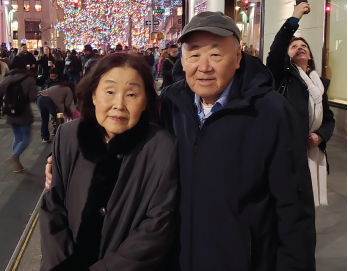I’m a believer in blue light. I’ve spent years lecturing my insomniac patients, buzzed on prednisone, on the importance of good sleep hygiene. In my own home, I try to practice what I preach. When I’m ready for bed, I leave my laptop and phone on my nightstand, and concentrate on relaxing. If I can’t unwind, I might listen to an audiobook. Most recently, my soporific of choice has been A Promised Land, narrated by the author, Barack Obama. I just close my eyes and allow the soothing sounds of democracy to wash over me, until I am lulled to sleep.
That all changed on Jan. 12, 2021, when the Centers for Disease Control and Prevention (CDC) expanded coronavirus vaccine eligibility to everyone older than 65 years. Overnight, the pool of eligible Americans increased by 53 million, a group that included an elderly couple in Manhattan, who happen to be my parents.1
I hate to describe my parents as a stereotype, but my dad once called me urgently when I was seeing patients because he accidentally muted his computer while watching a Korean soap opera and couldn’t figure out how to turn the volume back on. There was no way my parents were going to figure out how to register for coronavirus vaccination.
Apparently, neither could I.
Trying to determine how to get my parents vaccinated became my newest hobby. Night after night, I dragged my laptop into bed with me. I started to spend the waning hours of each day hunting for the elusive website that would reveal all.
I had already invested considerable time in learning how Florida was allocating its supply of vaccine. Like many older New Yorkers, my parents are snowbirds, who often migrate to Florida for the winter. I thought it would be easy enough to justify vaccinating them in Florida, based on their semi-residency. Even if that were not the case, Gov. Ron DeSantis had already announced that residency was not a requirement to receive a coronavirus vaccine in Florida, as long as the age requirement was met.
Otherwise, it was up to each Florida county’s department of health to come up with its own system to distribute vaccines equitably. Lee County, for example, adopted a first-come, first-served policy, arguing this was most fair for patients who might have difficulty using a computer-based scheduling system.2 Predictably, this led to elderly and at-risk patients camping out at vaccination sites with lawn chairs and blankets, as if they were trying to get into one last Grateful Dead concert. Neighboring Collier County gave out appointments for vaccines using Eventbrite, the same program I used to buy a ticket to a community fundraiser a few years ago. Broward County allowed residents to make vaccination appointments by phone, but its switchboard was rapidly overwhelmed. No matter; all of its appointments were snapped up within hours.

Hae Ja Yoon and Kyung Hwa Seo, the author’s parents, at Rockefeller Center, Christmas 2019.
New York City’s system was no easier to navigate. For the life of me, I could not figure out why the official registries seemed to list non-overlapping vaccination sites. I finally realized it was because the official registries did, indeed, list non-overlapping vaccination sites. Some were operated by New York City, while others were operated by the state; neither list acknowledged the existence of the other. I imagine this reflects the animus between the mayor and the governor of New York, who also try to avoid acknowledging each other’s existence.
I started with the mom-and-pop pharmacies listed on one of the registries, but neither the moms nor the pops would pick up their phones. I moved on to a chain pharmacy with a downtown branch that was offering the vaccine. When I tried to access its website, however, I was redirected to an electronic antechamber, which cheerfully indicated a few hundred people were ahead of me in queue. Once in, the site warned, I would have 15 minutes to schedule an appointment before being kicked out, so someone else could take their turn.
When Gov. Andrew Cuomo announced the state of New York was opening a mass vaccination center at the Jacob K. Javits Convention Center in Manhattan, I decided the new site probably gave me the best opportunity to snag an appointment before the rest of New York caught on. The night before the registration website was set to open, I again brought my computer to bed.
The next morning, as soon as I opened my eyes, I grabbed my laptop. The registration website was already live, and I started to make an appointment for my parents. As I was typing, I realized I had another problem: I could only register one parent at a time. Going to a mass vaccination site operated by the National Guard was daunting enough, but I really did not want my parents to have to make two separate trips.
To try to game the system, I picked an appointment toward the end of the day. It seemed like my fellow early risers were grabbing the first available appointments, so the later appointments remained untouched. By the time I had registered my father and re-entered the system to register my mother, many of those appointments had been claimed, as well. Fortunately, I was still able to get an appointment for my mother, 30 minutes after my father’s slot. Knowing how chaotic the vaccination center would be in the first few days, I knew that if my father showed up a little late for his appointment, and my mother showed up a little early for hers, no one would notice.
I was thrilled to get the appointments, but it was hard not to wonder: Is this really how the system is supposed to work?
Public Health on Life Support
In retrospect, we were so busy celebrating the advent of coronavirus vaccines that we forgot the real challenge would be getting the vaccine into patients’ arms. Until recently, the federal government saw its role as ending with the delivery of the vaccine to the states. What the states chose to do with the vaccine once it reached their borders was largely up to them.
This led to a disjointed, state-specific system that defies generalization. In two states, you qualify for vaccination if you are a smoker. In 15 states, you qualify if you are obese.3 Are you taking immunosuppression? Then you’re in luck—if you have a solid organ transplant. Most states don’t prioritize patients with rheumatic disease, even if they are taking the same immunosuppressive drugs. Several resources have popped up to help the confused, but often these websites only narrow your search to a smaller subset of subsidiary websites.4
The real problem with leaving vaccine distribution in the hands of the states comes down to a question of resources. All of the states, with the exception of Vermont, are required by statute to have balanced budgets; 38 states prohibit carrying a deficit from one year to the next.
These balanced budgets have been achieved, in part, by hollowing out state public health services. On average, spending on public health has been reduced to just 1.5% of a state’s budget. Since 2010, spending on state health departments has fallen by 16% per capita. Three-quarters of all states spend less than $100 per person on public health. In Louisiana, it’s $32 per person.5
Why was this serious underfunding of public health across the country allowed to take place? By and large, public health in the U.S. has been a victim of its own success. You know your state has an effective public health system when you forget it exists. You breathe clean air, you drink pure water, and you go about your life in blithe ignorance of the public health officials who are working like mad behind the scenes to keep you safe.
Because we forget about the importance of public health departments to maintaining public health, state legislatures cut their funding. This is roughly analogous to cutting funding to the local fire department because no buildings have burned down recently. And now that our house is on fire, we have finally realized no one left is in the firehouse to rescue us.
State public health systems have not been able to ramp up to meet the demands of vaccinating a state because they are operating on bare-bones budgets. State governments cannot quickly reallocate funds to support their public health departments because of their balanced budget requirements; to move money to support vaccination efforts, they would have to choose to cut funding to schools, or sanitation or some other mandatory governmental function that has also been taxed by the pandemic. To do otherwise would require a degree of political bravery that state legislators largely lack. Thus, most states are stuck making do with the public health systems they had in place pre-pandemic, which in most cases, was not much.
National Vaccination Strategies
The $1.9 trillion pandemic relief package approved by Congress includes $160 billion to support a national vaccination program. These funds will enable the federal government to take the following steps:6
- Reimburse states: States will be reimbursed for the costs of operating their vaccination programs, which will provide states with greater flexibility to support all of their needs.
- Create vaccination centers: These centers will be federally funded and supported by the Federal Emergency Management Agency (FEMA) and the National Guard. State and local officials will also remain involved, to ensure each center reflects the needs of the local community.
- Target congregate settings: Social distancing is essentially impossible in homeless shelters and prisons; targeting both may eliminate an important reservoir for viral spread.
- Leverage novel access points: Not everyone has a primary care provider. Plans are afoot to use community pharmacies and health centers to reach those who may not see a physician on a regular basis. For others, mobile vaccination centers will travel to meet patients more than halfway.
In the storied television series The West Wing, fictional president Jed Bartlet says, “There are times when we’re 50 states, and there are times when we’re one country and have national needs.”7 It seems like we are in the process of rediscovering what Aaron Sorkin, the writer and creator of The West Wing, knew in 2002. The piecemeal approach to vaccination, which depends on state and local public health agencies, is not adequately robust to defeat the gargantuan problem that faces us.
There is already a national infrastructure to track vaccine distribution nationwide. With some tweaks, this could be turned into a national vaccine registry to track who has been vaccinated and who has not. Such a registry may allow us to proactively reach out to individuals who need to be vaccinated, rather than waiting for them to find us.8
Of course, that would require we have some way of identifying the vaccine hesitant, who aren’t eager to be identified. That said, I know the government knows who I am, because I have a Social Security number and a driver’s license, I have registered to vote, I pay taxes, and I have been called for jury duty. None of these databases are an ideal resource for a vaccination registry, but any one of them might be a start.
The U.S. Department of Veterans Affairs may provide a good model for the rest of us. It has been actively reaching out to veterans to ensure those who have served don’t get left behind. It is even actively pursuing vets who are homeless, live in rural areas or otherwise may be harder to reach.9
The absence of such outreach risks leaving many patients behind, particularly the elderly. Older patients describe frustration with busy phone lines, conflicting sources of information and user-unfriendly websites that turn the process of trying to get vaccinated into a competition. For example, my state’s website notes that my institution offers coronavirus vaccination and suggests that you call to schedule an appointment. When you call, you hear a prerecorded message:
We recognize that COVID-19 vaccines are at the top of everyone’s minds, and we are eager to be a resource for all our patients and the public. Unfortunately,
we are unable to accept phone calls to schedule COVID-19 vaccinations at this time. We must keep our phone lines clear for people with urgent medical needs. When we are able to schedule by phone, we will communicate this information to patients and the public.
In other words: Don’t call us. We’ll call you. If I were on the fence about getting vaccinated, that message might be enough to make me give up. That’s a real problem.
In retrospect, we were so busy celebrating the advent of coronavirus vaccines that we forgot the real challenge would be getting the vaccine into patients’ arms.
My parents are lucky to have adult children who are reasonably computer savvy and slightly obsessive compulsive. Not everyone who needs to be vaccinated will be so lucky, and many will find it impossible to obtain coronavirus vaccination without a significant amount of support. We need to acknowledge that not everyone has internet access, not everyone is fluent in English and not everyone can afford to take a day off work to go to a vaccination supercenter.
As for my parents, I am pleased to report that obtaining the appointment for the vaccine was the hardest part of the process. When my sister brought them to the Javits Center, they were greeted by a phalanx of National Guardsmen, who ran the operation with an efficiency that I usually don’t associate with the government.
At the end of the appointment, my dad was beaming. After he rolled down his sleeve, he looked at the nurse who administered his vaccine, gave her a grin and declared, “I’m just so happy.”
 Philip Seo, MD, MHS, is an associate professor of medicine at the Johns Hopkins University School of Medicine, Baltimore. He is director of both the Johns Hopkins Vasculitis Center and the Johns Hopkins Rheumatology Fellowship Program.
Philip Seo, MD, MHS, is an associate professor of medicine at the Johns Hopkins University School of Medicine, Baltimore. He is director of both the Johns Hopkins Vasculitis Center and the Johns Hopkins Rheumatology Fellowship Program.
Coronavirus Vaccination Assistance
As of April 19, all adults in all 50 states are eligible for vaccination. Below, we list some online resources created to help people schedule an appointment:
- VaccineFinder allows you to search for a location by vaccine and ZIP code: https://vaccinefinder.org
- How to Sign Up for a COVID-19 Vaccine in Your State. NPR (KQED). This site allows you to search for availability, but also offers advice for navigating the system.
- AARP Coronavirus page
- State-by-State Guide to COVID Vaccine Information. WebMD
- How to Get a COVID-19 Vaccine. A State-by-State Guide. The Wall Street Journal.
ACR Vaccine Clinical Guidance Summary
In addition, the ACR has developed new guidance for rheumatology providers on the use of COVID-19 vaccines for patients with rheumatic and musculoskeletal diseases. All recommendations are based on current knowledge and will be revised as circumstances and evidence evolve.
References
- Lovelace Jr. B. CDC expands COVID vaccination guidelines to everyone 65 and older. CNBC. 2021 Jan 12.
- Levenson E, Barajas A, Young R. Florida’s first-come, first-serve COVID-19 vaccination plan for the elderly leads to scramble. CNN. 2020 Dec 30.
- Landsverk G. Check to see if your BMI is in the ‘obese’ range, because you may be able to get an early COVID-19 vaccine. Business Insider. 2021 Feb 19.
- How to sign up for a COVID-19 vaccine in your state. NPR (KQED). 2021 Feb 18.
- Weber L, Ungar L, Smith MR, et al. Hollowed-out public health system faces more cuts admid virus. KHN. 2020 Jul 1. Updated 2020 Aug 24.
- Fact sheet: President-elect Biden outlines COVID-19 vaccination plan. The White House. 2021 Jan 15.
- Sorkin A, Redford P. ‘Game On.’ The West Wing. 2002 Oct 30.
- Haseltine W. The US must develop a national vaccine registry. The Hill. 2021 Jan 18.
- Bolton A. How Veterans Affairs is helping rural vets get the COVID-19 vaccine. NPR. 2021 Feb 8.



